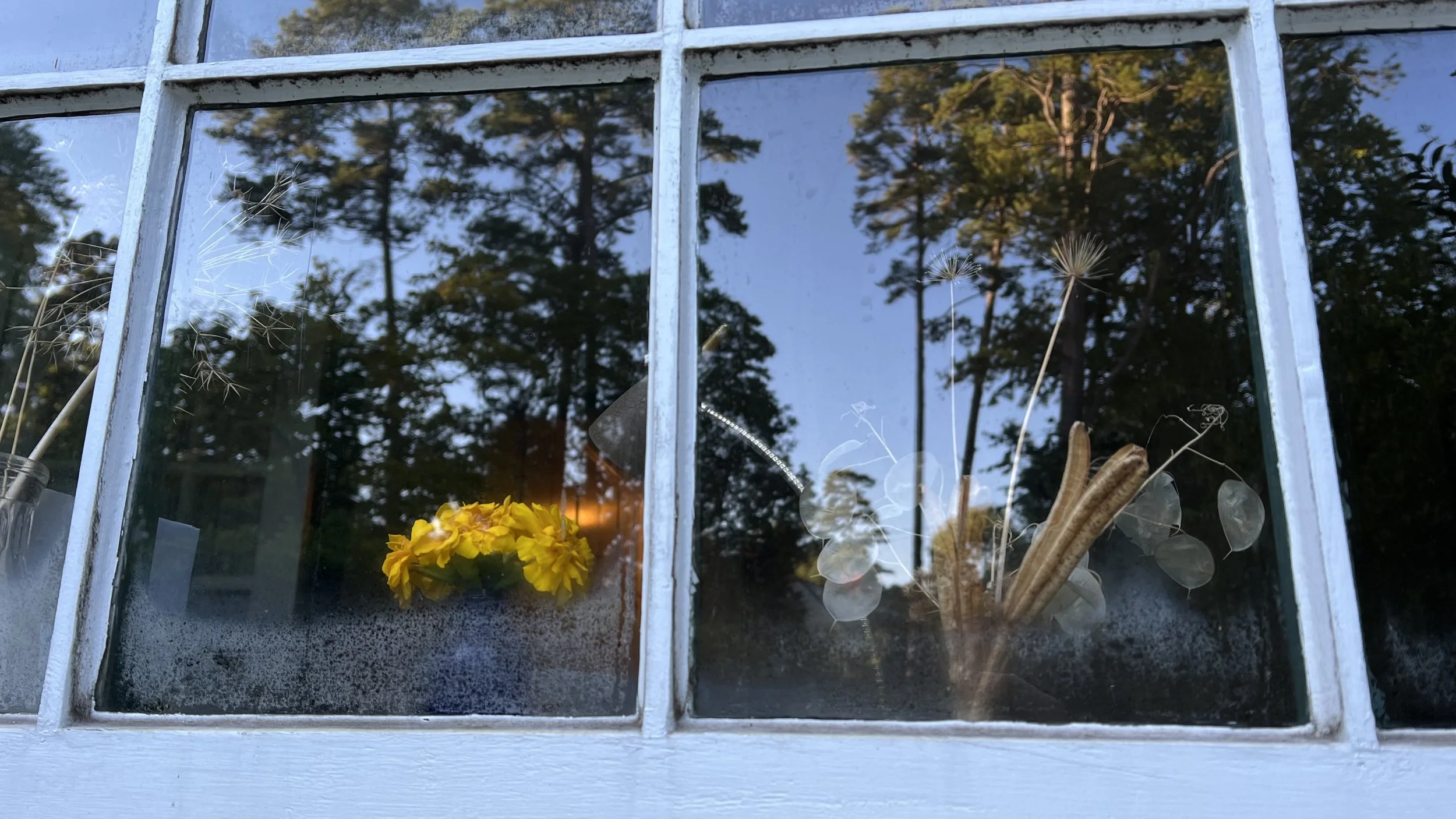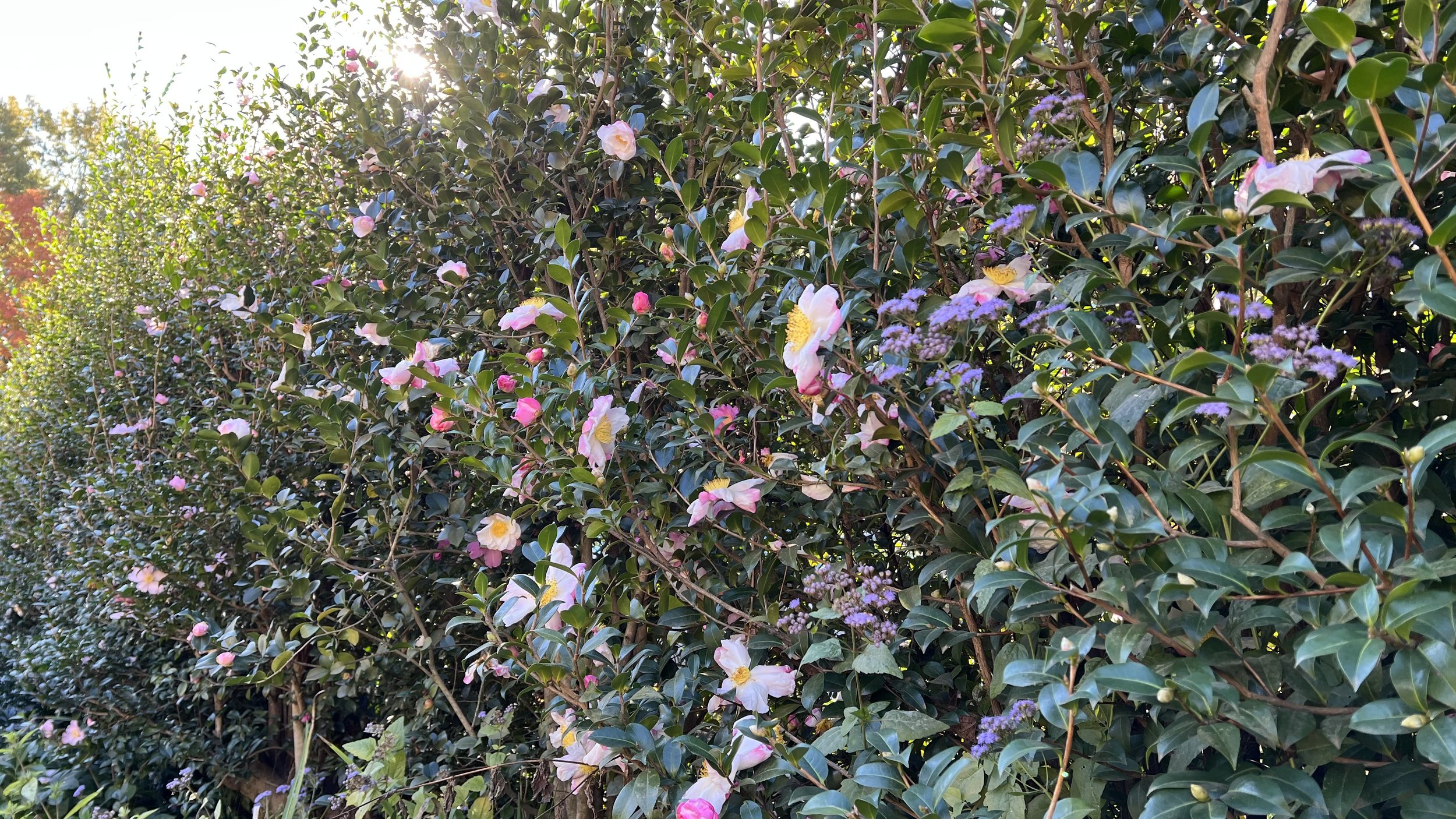It always catches me by surprise, that sudden change from late summer to autumn. And now, as I sit outside on a sunny day at noon and write this, it is a crisp and almost jarringly chilly 45˚F, just six hours after the lowest temperature we’ve seen in six months. They said it hit 32˚F, which it very well may have, but in all parts of Elizabeth Lawrence’s garden there are no hints of frost, much less a freeze.
Autumn glows in all parts of the garden.
At the edge of the main path, her Chrysanthemum “Little Pink Daisy” dances in the cool breeze; leaning stems bob in between the foliage and spent flowerheads of Patrinia scabiosaefolia (golden lace), now clothed in kaleidoscopic warm hues. Farther down the path, in the back of the middle border, original plantings of Helianthus angustifolius (narrow-leaf sunflower) and H. giganteus (mountain sunflower) form a gently waving, nearly 10’ tall wall of sunshine. Upon closer inspection, the mass of bright yellow flowers almost vibrates with the buzz and hum of brave bumblebees, out foraging for even more pollen and nectar to pack into their hives.
The borders are resplendent with brilliant tones of Anemone ‘Margarete’, Gomphrena ‘Fireworks’ and Cosmos sulphureus—peppered with the tiny white twinkling froth of Calico aster (Symphyotrichum lateriflorum), prairie fleabane (Erigeron strigosus) and the last of the Boltonia asteroides—and all tied together with the ebb and flow of a lavender blue river of hardy ageratum (Eupatorium coelestinum) which seamlessly knits with the cool blue of ‘Raydon’s Favorite’ aster. A lone bloom of Elizabeth’s Hemerocallis ‘Sonata’ raises its delicate ivory head in the midst of the balanced masses of saturated color. This daylily has become one of my favorites. This is its second, and I think best, flowering. Its first flush, usually early July, comes at a time when the hot summer sun bleaches a lot of the life out of the thin petals. Now, in the coolness of autumn, it has the chance to really shine in all its demure glory.
Elizabeth’s Hemerocallis ‘Sonata' blooms twice a year.
The ageratum ties the whole sunny area of the garden together. In the lowest border, which was entirely renovated less than two years ago, it weaves in and out of the gangly growth of Elizabeth’s ‘Pink Lady’ quince and a ’Bon Silene’ rose. It also provides a frothy base for tall, flowerless (but still green) stalks of lilies, a seedling Helianthus, and a single blooming stem of Phlox paniculata ‘Mt. Fuji’—the brightest, purest white phlox I’ve ever seen.
Another sign of the changing seasons comes first to the nose rather than the eye. At least four different types of osmanthus, all original to Elizabeth, are in perfection. What begins as a haunting quintessential whiff of fall in the South turns into a sickeningly sweet, transparent fog. In this one-third acre plot, it can be difficult to get away from the scent. Yes, there really can be too much of a good thing sometimes. Thankfully, this bashing bouquet is fairly short-lived—three weeks all-told.
The back of the garden (“our woods”) is lit with the brilliance of foliage of bottlebrush buckeye and a cherry tree seedling.
In the back of the garden, what Elizabeth called “our woods”, begins its autumnal transformation with the warm yellow-orange foliage of Elizabeth’s bottlebrush buckeye (Aesculus parviflora). Masses of ruddy berries hang on nandina, while butcher’s broom (Ruscus aculeatus) and poet’s laurel (Danae racemosa) fruits change from green to tones of deep orange and warm red. Tiny pink and white whirligigs of hardy cyclamen (Cyclamen hederifolium) dot the ground, and a couple of clumps of meadow saffron (Colchicum) pop up here and there.
Tiny whirligig flowers of hardy cyclamen bring cheer to the ground plane of the woods.
All parts of the garden have camellias bursting with buds, with many coming into bloom. The beauty starts at the street with Elizabeth’s Camellia sasanqua hedge, which is quickly filling the long bed that separates the sidewalk from the parking court with petals in varying shades of pink, white and apple blossom. As I write this, I realize that the Camellia is a thread that runs through the entire property… a thread of amazing floral diversity for eight months of the year. Right now, autumn-flowering camellias seamlessly take up the bloom mantle with the changing of the guard from the perennial-rich show of summer.
The hedge of Camellia sasanqua “Hybrids” separates the street from the parking court.
This is a time of the year when Elizabeth Lawrence’s multi-faceted design brilliance shines. Her planting schemes, which are literally and figuratively layered, continue to inspire and challenge me to be a more thoughtful designer and gardener.
To me, there is no time in her garden when her fingerprint is more evident than in the changing seasons.
Yours in Dirt,
Andrea






